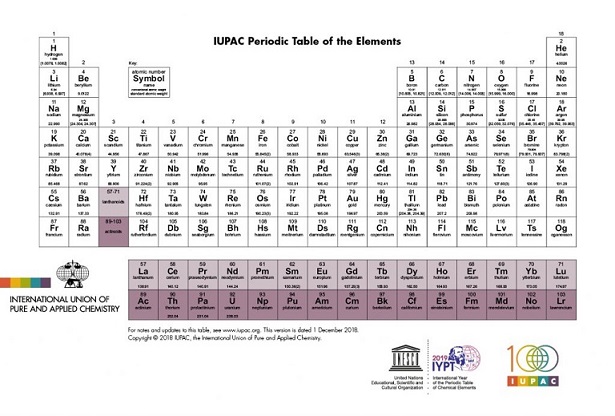
International Year of the Periodic Table 2019 recognizes Mendeleev's achievements
2019 is the 150th anniversary of the Periodic Table of Chemical Elements and has been proclaimed the "International Year of the Periodic Table (IYPT 2019)" by the United Nations General Assembly and UNESCO.
The periodic classification of the elements was proposed in 1869 by Dmitri Ivanovich Mendeleev, a Russian chemist and former member of the CIPM. He found that by arranging the known elements in order of increasing atomic weight (relative atomic mass), their chemical and other properties regularly repeated. He was therefore able to make a more compact arrangement that was also predictive. By 1871, he produced a more satisfactory version of the table where he left gaps, hoping that they would one day be filled by elements not yet known and predicting with uncanny accuracy the properties of three of those elements, which were very soon discovered: gallium, scandium and germanium. He also predicted a fourth missing element with an atomic weight (relative atomic mass) of about 100. This turned out to be technetium, the lightest element that has no stable isotopes. Mendeleev relied in part on atomic weights accurately measured by Jean-Servais Stas, a Belgian analytical chemist who had also been an important member of the CIPM from its inception in 1875 until his death in 1891, aged 78.
Mendeleev was awarded the Royal Society's award for achievements in chemistry, the Davy Medal, in 1882 (shared with Lothar Meyer, a German chemist). Stas received the same award in 1885.
From 1895 to 1901 Mendeleev was a CIPM member, a role for which he was well qualified following his appointment in 1892 as director of the Main Chamber of Weights and Measures of the Russian Empire (now known as the D.I. Mendeleev Institute for Metrology). During that period he also served as a member of the CIPM Commission on Instruments and Works. He was unanimously granted the status of Honorary member of the CIPM upon his retirement in 1901.
His proposal to complete the redefinition of the unit of volume - the litre by specifying the reference air pressure at which 'one kilogram of pure water at its maximum density (about 4 °C) occupies one litre' was unanimously adopted at the CIPM meeting in 1897 and became incorporated in Resolution 1, 'Declaration concerning the definition of the litre' of the 3rd meeting of the CGPM (1901). (Although his suggestion to specify the air pressure illustrates Mendeleev's life-long attention to detail, the idea of defining the litre to be slightly different from 1000 cm3 did not stand the test of time and was abrogated in 1964, making the litre simply equal to 1000 cm3.)
Mendeleev's 'Examination of Relationship between the Fundamental Measurements of Russia, France and Great Britain based on the data at the beginning of 1897' was published as an Annex to the Minutes of the 20th meeting of the CIPM (1897).